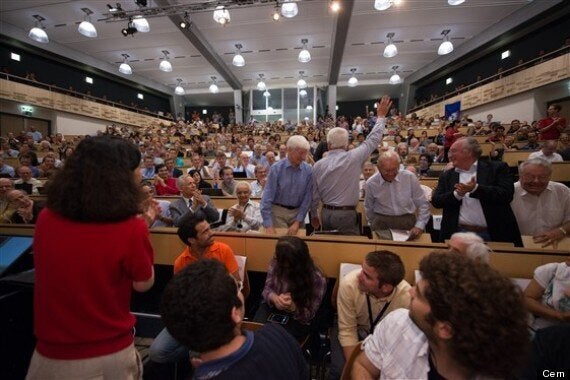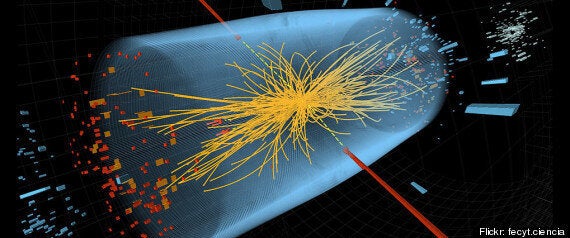Scientists believe they have captured the elusive "God particle" that gives matter mass and holds the universe together.
Researchers from the CMS and Atlas experiments at Cern, the European Organisation for Nuclear Research in Geneva, announced that the £2.6bn "Big Bang" accelerator had found strong evidence of a particle which behaves like the Higgs boson.

Scientists applaud during a seminar on the update in the search for a particle called the Higgs Boson
The Higgs Boson particle has a mass that's around 130 times that of a proton, in the 125-6 GeV mass range, making it the most massive particle that exists.

As the announcement was made, the scientists present broke into thunderous, spontaneous applause
The two experiments were run independently from each other, and even most of the scientists at Cern had not seen the combined results until Wednesday morning. Only one third of the 2012 data has been captured and analysed.
“We have reached a milestone in our understanding of nature,” said Cern Director General Rolf Heuer, in a press statement.
"The discovery of a particle consistent with the Higgs boson opens the way to more detailed studies, requiring larger statistics, which will pin down the new particle’s properties, and is likely to shed light on other mysteries of our universe."
Professor John Womersley, chief executive of the Science and technology Facilities Council, told reporters at a briefing in London: "They have discovered a particle consistent with the Higgs boson.
"Discovery is the important word. That is confirmed. It's a momentous day for science."
Professor Higgs, currently at the University of Edinburgh, welcomed the Cern results, telling Sky News: "I never expected this to happen in my lifetime and shall be asking my family to put some champagne in the fridge."
Dr Joel Goldstein, leader of the CMS activity in Bristol, said: "If the Higgs has been finally identified, this will be the biggest particle physics discovery for forty years."

Above: a visualisation of the experiment at Cern which has led to the Higgs discovery
The Higgs mechanism helps to explain how particles acquire mass, which helps us to understand the basic building blocks of the universe.
Scientists said they are now almost 100% certain that the observed particle is the Higgs. The evidence met the usual particle physics threshold for a discovery. The accuracy from the CMS experiment was 4.9 sigma - or about one in three million.
Findings from the Atlas experiment were consistent with the findings from CMS.
“We observe in our data clear signs of a new particle, at the level of 5 sigma, in the mass region around 126 GeV," said ATLAS experiment spokesperson Fabiola Gianotti.
"The outstanding performance of the LHC and ATLAS and the huge efforts of many people have brought us to this exciting stage but a little more time is needed to prepare these results for publication.”
CMS Results: All the data and charts from CMS
Atlas Results: all the evidence from Atalas
The announcements were made at Cern in a live webcast, attended by key scientists and watched around the world online.
And while they cautioned it was "very early" in the process, Joe Incandela, spokesman for the CMS experiment at LHC, confirmed "we have discovered a new boson" and confirmed it behaved as expected.
Meanwhile on Twitter the reaction was enormous - both for the discovery, and the use of the widely-derided font Comic Sans in the official announcement.
Professor Tom Kibble, Imperial College London, who predicted that a particle like the Higgs boson existed more than five decades ago, told the Huffington Post he was excited by the news.
"It's very exciting, i'm very pleased of course. Its been a gradual build up to this, it's been clear that this is quite probable," he said.
"It's a very important step in verifying the standard model.. but going on from there I don't think it changes anything [about physics] fundamentally.
"This is not an absolute discovery yet. They've certainly discovered a particle of somekind but they haven't verified all its properties."
Cern Research Director Sergio Bertolucci said “It’s hard not to get excited by these results".
"We stated last year that in 2012 we would either find a new Higgs-like particle or exclude the existence of the Standard Model Higgs.
"With all the necessary caution, it looks to me that we are at a branching point: the observation of this new particle indicates the path for the future towards a more detailed understanding of what we’re seeing in the data."
On Twitter Professor Brian Cox, who is working on one experiment at the Large Hadron Collider, was excited by the results.
But the process of proving the Higgs is real remains a gradual one, similar to getting closer to a familiar face seen from afar.
In December last year scientists at the Large Hadron Collider (LHC) - the "Big Bang" particle accelerator which recreates conditions a billionth of a second after the birth of the universe - revealed they had caught a first tantalising glimpse of the Higgs.
MORE: What Is The Higgs And Why Does It Matter?
Higgs Boson Discovery: Scientists React With Joy At Finding The God Particle (PICTURES)
Higgs Boson Discovered: The Pictures That Prove The God Particle Exists
Since then they have sifted through vast quantities of data from innumerable high energy collisions in an effort to reduce the odds of being wrong.
At the LHC, scientists shoot two beams of protons - the "hearts" of atoms - at each other round 27 kilometres of circular tunnels at almost the speed of light.
When the protons smash together the enormous energies involved cause them to decay into an array of more fundamental particles. These may then decay further into yet more particles.
By following the decay patterns, scientists hope to see the "fingerprint" of the Higgs boson.

Above: Emeritus professor at the University of Edinburgh, Peter Higgs, is best known for his theory explaining the origin of mass of elementary particles in general and the Higgs Boson in particular.
STFC Chief Executive, Professor John Womersley said:
“I’m delighted that we have indeed discovered a particle consistent with the Higgs boson! These results mark a significant breakthrough in our understanding of the fundamental laws that govern the Universe.
"Obviously having found a new particle, there is still much, much more to do at the LHC – we need to confirm that this new particle is the reason some particles have tangible mass while others are insubstantial, as proposed by Peter Higgs and other scientists, who predicted that a particle like this one must exist for our current understanding of the Universe to work."
Minister for Universities and Science David Willetts said:
“This news from CERN is a breakthrough in world science. The UK has made an enormous contribution over the last 20 years supporting the search for the Higgs Boson. Our researchers, universities and industry partners have been instrumental in making the Large Hadron Collider such a success."
Physicists need the Higgs to plug a gaping hole in the "Standard Model", the theory that explains all the particles, forces and interactions making up the universe.
So far nothing has been observed to account for mass, and the fact that some particles weigh more than others.
According to the theory, the Higgs boson is the emissary of an all-pervading "Higgs field" that gives matter mass. The more particles interact with the field, the more massive they become and the heavier they are.
A Standard Model universe without the Higgs boson could not exist. Everything would behave as light does, floating freely and not combining with anything else. There would be no atoms, made from conglomerations of protons, neutrons and electrons, no ordinary matter, and no us.